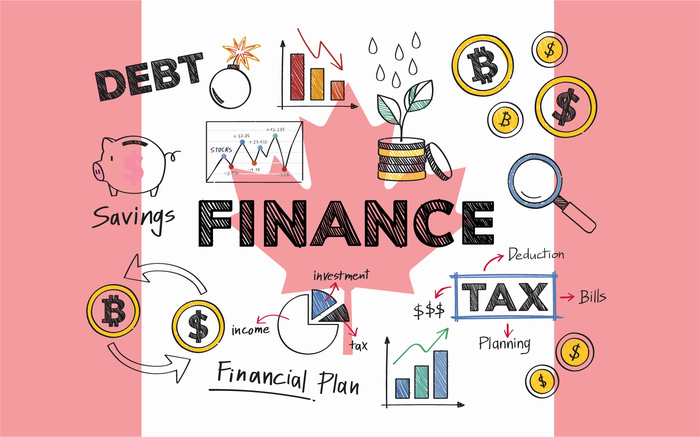Navigating the complexities of personal finance can be a formidable undertaking, and for many individuals, it remains an enigmatic and intimidating prospect. Whether you’re at the outset of your career or bracing yourself for the twilight years of retirement, harnessing the power of your finances can be instrumental in realizing your aspirations and attaining the life you’ve always dreamed of. Nevertheless, untangling the intricacies of financial management can be a perplexing task, and it’s a challenge that many people find daunting.
Fortunately, this all-encompassing guide provides you with the tools you need to make sense of it all. Using the exhaustive and rigorous MECE framework, we will lead you through the labyrinthine journey of financial self-mastery, illuminating the odyssey from the initial step of evaluating your current financial state to the final milestone of monitoring your progress and adapting your strategy as necessary. After completing this journey, you will emerge with a clear and profound comprehension of how to seize control of your fiscal future and attain your financial goals with ease and precision.
Step 1 – Assess Your Current Financial Situation
Overview: Before changing your financial situation, you must know where you stand. This step will guide you through assessing your current financial situation by examining your income, expenses, debts, assets, and liabilities.
- Calculate your income: Start by calculating your total income, including your salary, bonuses, investments, and any other sources of income.
- Track your expenses: Keep a record of your monthly expenses, including everything from rent/mortgage payments, utility bills, and grocery bills to entertainment and leisure activities.
- Analyze your debts: Take stock of all your debts, including credit card balances, loans, and mortgages. Note down the interest rates and payment schedules of each debt.
- Evaluate your assets: List your assets, such as your house, car, investments, and savings accounts. Determine their market value and assess how easily you could sell them if needed.
- Assess your liabilities: Note down any liabilities, such as outstanding bills or taxes, that you owe. Determine the interest rates and payment schedules of each liability.
FAQs:
- What is the importance of assessing my current financial situation?
Assessing your current financial situation is the first step towards achieving your financial goals. By taking stock of your income, expenses, debts, assets, and liabilities, you’ll gain a clear understanding of where you stand financially. This knowledge is essential for making informed decisions about how to manage your money and plan for the future.
- How can I calculate my total income accurately?
To calculate your total income accurately, you should start by adding up all sources of income, including your salary, bonuses, investments, and any other income streams you may have. Be sure to factor in any deductions, such as taxes or retirement contributions that may reduce your take-home pay.
- What expenses should I include when tracking my monthly expenses?
When tracking your monthly expenses, you should include all of your regular expenses, such as rent/mortgage payments, utility bills, groceries, transportation, and healthcare. You should also account for discretionary expenses, such as entertainment and leisure activities, as these can significantly impact your overall financial situation.
- What is the best way to manage my debts?
Managing your debts requires a combination of strategies, including creating a repayment plan, prioritizing high-interest debts, and negotiating with creditors. It’s also important to avoid taking on new debts and to make timely payments on existing debts to avoid further interest and fees.
- How can I determine the market value of my assets?
To determine the market value of your assets, you can use online tools or consult a professional appraiser. You should also consider the asset’s condition, the demand for it in the market, and any other relevant factors that may impact its value.
Step 2 – Set Financial Goals
Overview: In this step, you’ll learn how to set financial goals that are specific, measurable, achievable, relevant and time-bound. Setting goals will help you prioritize your spending, focus on your objectives, and track your progress over time.
- Identify your short-term and long-term goals: Start by identifying your short-term and long-term financial objectives. Short-term goals may include paying off credit card debt or saving for a down payment on a house, while long-term goals may include retiring comfortably or starting your own business.
- Make your goals SMART: To ensure they are effective, they should be Specific, Measurable, Achievable, Relevant, and Time-bound. For example, a SMART goal could be to save $10,000 for a down payment on a house within the next 12 months.
- Prioritize your goals: Once you’ve identified them, you should prioritize them based on their importance and urgency. This will help you focus your efforts and allocate your resources accordingly.
- Create a budget: A budget is critical to achieving your financial goals. A budget will help you identify areas to reduce spending and redirect those resources towards your goals.
- Review and adjust your goals regularly: Your financial goals may change over time, so it’s important to review and adjust them regularly. This will help you stay on track and ensure your goals remain relevant and achievable.
FAQs:
- How can setting financial goals help me manage my finances better?
Setting financial goals can help you manage your finances better by giving you a clear direction for your money. When you have specific goals in mind, you can prioritize your spending, cut back on unnecessary expenses, and make informed decisions about allocating your resources.
- What is a SMART financial goal?
A SMART financial goal is a goal that is Specific, Measurable, Achievable, Relevant, and Time-bound. Specific means that your goal is clear and well-defined. Measurable means that you can track your progress, Achievable means that your goal is realistic, Relevant means that your goal is aligned with your values and priorities, and Time-bound means that your goal has a deadline.
- How do I prioritize my financial goals?
To prioritize your financial goals, identify which are most important to you. Consider factors such as urgency, impact, and feasibility. Once you clearly understand your priorities, you can allocate your resources accordingly.
- What should I consider when creating a budget?
When creating a budget, it’s important to consider your income, expenses, debts, and financial goals. You should also factor in any irregular or unexpected expenses, such as car repairs or medical bills. Additionally, it’s important to be realistic about your spending habits and to account for discretionary expenses, such as entertainment and leisure activities.
- How often should I review and adjust my financial goals?
You should review and adjust your financial goals regularly, ideally every six months to a year. This will allow you to track your progress, assess your current financial situation, and make any necessary adjustments to your goals or plan. Additionally, major life events, such as getting married, having a child, or starting a new job, may require you to revise your goals or budget.
Step 3 – Develop a Budget Plan
Overview: In this step, you’ll learn how to develop a budget plan that aligns with your financial goals. A budget plan will help you manage expenses, reduce debt, and increase your savings. By creating a detailed plan, you can stay on track and make informed decisions about your spending.
- Track your income and expenses: Start by tracking your income and expenses over a period of time, such as a month. This will give you a clear picture of where your money is going and help you identify areas where you can cut back.
- Categorize your expenses: Once you’ve tracked your expenses, categorize them into essential and non-essential expenses. Essential expenses include things like rent, utilities, and groceries, while non-essential expenses include things like dining out and entertainment.
- Set spending limits: Based on your income and financial goals, set spending limits for each category of expenses. Be realistic about your limits and adjust them as needed.
- Create a savings plan: In addition to managing your expenses, it’s important to have a savings plan. Set a specific savings goal, such as saving 20% of your income each month, and create a plan to achieve it.
- Monitor your progress: Regularly monitor your progress against your budget plan. This will help you stay on track and make any necessary adjustments.
FAQs:
- Why is it important to have a budget plan?
Having a budget plan is important because it helps you manage your finances and achieve your financial goals. With a budget plan, you can track your income and expenses, prioritize your spending, and make informed decisions about how to allocate your resources.
- How can I track my expenses?
You can track your expenses by keeping a record of your spending over a period of time, such as a month. Use a spreadsheet, an app, or a pen and paper to record every expense, including small purchases like coffee or snacks. Be sure to categorize your expenses so you can see where your money is going.
- What should I consider when setting spending limits?
When setting spending limits, consider your income, expenses, financial goals, and priorities. Be realistic about your limits and adjust them as needed. Remember to prioritize essential expenses like rent, utilities, and groceries over non-essential expenses like entertainment and dining out.
- How can I create a savings plan?
To create a savings plan, start by setting a specific savings goal, such as saving 20% of your income each month. Then, create a plan to achieve your goal. This might include setting up automatic transfers from your checking account to a savings account, cutting back on non-essential expenses, or finding ways to increase your income.
- How often should I monitor my progress against my budget plan?
You should monitor your progress against your budget plan regularly, ideally on a monthly basis. This will help you stay on track and make any necessary adjustments to your plan. If you experience a major life event, such as a job loss or a medical emergency, you may need to revise your budget plan sooner.
Step 4 – Implement Saving and Investment Strategies
Overview: In this step, you’ll learn how to implement saving and investment strategies that align with your financial goals. Saving and investing is essential for building wealth and achieving financial security. By developing a strategy and sticking to it, you can grow your savings over time and make your money work for you.
- Determine your savings goals: Start by determining your short-term and long-term savings goals. Short-term goals might include building an emergency fund, while long-term goals might include saving for a down payment on a house or retirement.
- Choose a savings account: Once you have your goals in mind, choose a savings account that aligns with your needs. Look for an account with a high-interest rate and low fees.
- Develop an investment strategy: In addition to saving, investing is a key component of building wealth. Develop an investment strategy that aligns with your risk tolerance and financial goals. Consider diversifying your investments across different asset classes, such as stocks, bonds, and real estate.
- Consider retirement accounts: Retirement accounts, such as 401(k)s and IRAs, are powerful tools for building wealth over the long term. Consider contributing to these accounts to take advantage of tax benefits and employer matching programs.
- Review and adjust your strategy: Regularly review your savings and investment strategy and make adjustments as needed. Consider working with a financial advisor to ensure that your strategy aligns with your goals and risk tolerance.
FAQs:
- How much should I save each month?
The amount you should save each month depends on your financial goals and your current financial situation. As a general rule of thumb, aim to save at least 20% of your income each month. However, if you have debt or other financial obligations, you may need to adjust this amount.
- What type of savings account is best?
The best type of savings account depends on your needs and goals. Look for an account with a high-interest rate and low fees. Consider factors such as accessibility, convenience, and the minimum balance required to open the account.
- How do I choose investments?
Choosing investments involves assessing your risk tolerance and financial goals. Consider factors such as your time horizon, investment goals, and diversification. You may want to work with a financial advisor to help you choose the right investments.
- What are the benefits of contributing to a retirement account?
Contributing to a retirement account has several benefits, including tax advantages and employer-matching contributions. Retirement accounts are designed to help you save for retirement and can help you build a nest egg over time.
- When should I review and adjust my saving and investment strategy?
You should review and adjust your saving and investment strategy regularly, ideally on an annual basis. However, you may need to adjust your strategy more frequently if your financial situation or goals change. For example, if you receive a windfall or experience a job loss, you may need to adjust your strategy to reflect these changes.
Step 5 – Manage Debt and Credit
Overview: In this step, you’ll learn how to manage your debt and credit to improve your financial health. Debt and credit can be powerful tools for achieving your financial goals, but they can also be a source of stress and financial instability if mismanaged. By learning how to manage debt and credit effectively, you can build a strong financial foundation and achieve your financial goals.
- Assess your debt: Start by assessing your debt and understanding your debt-to-income ratio. This will help you determine how much debt you can afford and create a plan to pay off existing debt.
- Create a debt repayment plan: Develop a debt repayment plan that prioritizes high-interest debt and balances affordability with timely repayment.
- Build good credit habits: Good credit habits, such as paying bills on time and monitoring your credit report, can help you build a strong credit score and access credit when you need it.
- Use credit responsibly: Credit can be a powerful tool for achieving your financial goals, but it must be used responsibly. Avoid carrying a high balance, pay bills on time, and keep your credit utilization ratio low.
- Seek help if needed: If you’re struggling with debt or credit, don’t be afraid to seek help. Consider working with a credit counsellor or financial advisor to develop a plan to improve your financial health.
FAQs:
- How can I improve my credit score?
You can improve your credit score by paying bills on time, keeping your credit utilization ratio low, and monitoring your credit report for errors.
- How much debt is too much?
The amount of debt that is too much depends on your financial situation and goals. As a general rule of thumb, you should aim to keep your debt-to-income ratio below 36%.
- Should I pay off high-interest debt first?
Yes, it is generally recommended that you pay off high-interest debt first. This can save you money on interest payments and help you become debt-free more quickly.
- How do I know if I need help managing my debt?
If you are struggling to make debt payments or your debt-to-income ratio is high, you may need help managing your debt. Consider working with a credit counsellor or financial advisor to develop a plan to improve your financial health.
- What should I do if I can’t make my debt payments?
If you can’t make your debt payments, don’t ignore the problem. Contact your creditors and explain your situation. You may be able to negotiate a payment plan or other solution that can help you avoid defaulting on your debt.
Step 6 – Monitor Your Progress and Adjust as Needed
Overview: In this final step, you’ll learn how to monitor your financial progress and adjust your plan as needed. Financial management is an ongoing process that requires regular monitoring and adjustments to stay on track. By regularly reviewing your budget, goals, and investments, you can ensure that you’re making progress toward your financial goals and adjust your plan as needed to stay on track.
- Review your budget regularly: Regularly reviewing your budget can help you identify areas where you can cut costs and make adjustments to your spending plan.
- Check your progress toward your financial goals: Review your progress toward your financial goals regularly and adjust your plan as needed to ensure you’re on track to achieving them.
- Evaluate your investments: Regularly evaluating your investments can help you make informed decisions about your portfolio and ensure that your investments are aligned with your financial goals.
- Adjust your plan as needed: As your financial situation and goals change, it’s important to adjust your plan as needed to ensure that it remains aligned with your current circumstances.
- Celebrate your progress: Celebrate your progress and achievements along the way to keep yourself motivated and engaged in the financial management process.
FAQs:
- How often should I review my budget?
It’s recommended that you review your budget at least once a month to ensure you’re staying on track with your financial goals.
- How can I stay motivated to achieve my financial goals?
Staying motivated to achieve your financial goals can be challenging. One way to stay motivated is to celebrate small milestones along the way. It’s also helpful to remind yourself of the benefits of achieving your goals, such as financial security or the ability to afford a big purchase.
- How do I know if my investments are performing well?
You can evaluate the performance of your investments by tracking their returns over time and comparing them to benchmark indices or industry averages. It’s also important to consider the risk associated with your investments and whether they are aligned with your overall financial goals.
- How often should I adjust my financial plan?
You should adjust your financial plan as needed based on changes in your financial situation or goals. This may be as frequently as every few months or as infrequently as once a year.
- Should I celebrate small financial milestones or only big achievements?
It’s important to celebrate both small milestones and big achievements. Celebrating small milestones can help you stay motivated and engaged in the financial management process while celebrating big achievements can help you acknowledge your progress and accomplishments.




